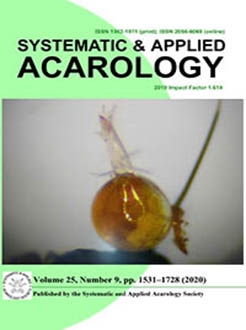The oriental armyworm, Mythimna separata (Walker) (Lepidoptera: Noctuidae), is a notorious migratory pest of cereal crops. Pyemotes zhonghuajia Yu, Zhang & He (Prostigmata: Pyemotidae) is an ectoparasitic mite with great potential in controlling many species of Lepidoptera, Coleoptera, and Homoptera. To evaluate the control efficiency of P. zhonghuajia on M. separata, we tested how initial density (1, 5, 10, or 20 mites) of P. zhonghuajia affected the mortality of oriental armyworm and the number of P. zhonghuajia fed upon individual hosts, and also determined the diameter growth of the opisthosoma and reproduction of P. zhonghuajia at different life stages of M. separata. Our results show that differing densities of P. zhonghuajia could significantly affect the mortality rate of different life stages of M. separata and the recruitment number of P. zhonghuajia on hosts, and there were significant differences in the development and reproduction parameters of P. zhonghuajia on different immature stages of M. separata. A single P. zhonghuajia could cause at least a 50% mortality rate of M. separata first to third instar larvae within 48 h. At higher density of 20 P. zhonghuajia, 100% of first to fourth and 30% of fifth instar larvae of M. separata were killed within 24 h. All prepupae and pupae of M. separata died when they were exposed to 10 and 20 P. zhonghuajia, respectively. In addition, density of P. zhonghuajia significantly influenced their adult recruitment of the body surface of M. separata. Pyemotes zhonghuajia could only complete development and reproduction on M. separata eggs, prepupae and pupae. However, the longevity, opisthosoma size and fecundity of P. zhonghuajia paralyzed on prepupae and pupae were significantly higher than those on eggs. In conclusion, P. zhonghuajia might be a suitable biological control agent against the oriental armyworm, and M. separata prepupae and pupae may be used as alternative prey for the mass rearing of P. zhonghuajia.
How to translate text using browser tools
18 September 2020
Biological control efficiency of an ectoparasitic mite Pyemotes zhonghuajia on oriental armyworm Mythimna separata
Tai-An Tian,
Lichen Yu,
Guang-Jun Sun,
Xiao-Fei Yu,
Litao Li,
Cheng-Xu Wu,
Yi-Chai Chen,
Mao-Fa Yang,
Jian-Feng Liu
ACCESS THE FULL ARTICLE
development
fecundity
mortality rate
Mythimna separata
Pyemotes zhonghuajia





